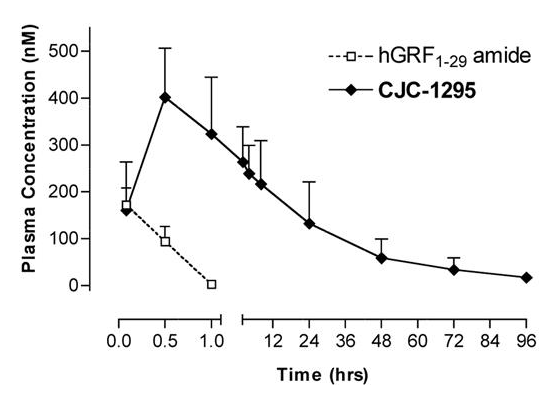CJC-1295, also known as CJC-1295 DAC, is a synthetic similar of growth hormone-releasing hormone (GHRH) growth hormone-releasing factor (GRF), which was developed by ConjuChem. It is a modified form of GRF (1-29), with an improved half-life. CJC-1295 markedly increases plasma growth hormone (GH) and insulin-like growth factor 1 (IGF-1) levels in both animals and humans. Clinical studies have shown that the administration of CJC-1295 may increase body weight, increase total pituitary RNA and growth hormone. The increase in total pituitary RNA and growth hormone suggests that more growth hormone releasing cells were created.
GHPeptides™ CJC-1295 DAC has a peptide purity level that exceeds 99.0% as determined by HPLC. This peptide was synthesized with no additives and is supplied as a white lyophilized (freeze-dried) powder.
It is recommended to reconstitute the lyophilized CJC-1295 DAC in sterile water, which can then be further diluted in other aqueous solutions. Lyophilized CJC-1295 DAC although stable at room temperature for 3-4 weeks, should be stored desiccated below -18°C. Upon reconstitution, CJC-1295 DAC should be stored at 4°C out of direct light for between 10-14 days and for future use below -18°C. Prevent repeated freeze-thaw cycles.
This product has been synthesized for in-vitro laboratory studies to be performed with cells or biological molecules. This product is not a drug and has not been approved by the FDA to prevent or cure any medical condition or disease. The purchaser is solely liable for risk involved with using this product for any purpose outside of in vitro studies.
Growth hormone releasing hormone (GHRH) has been modified a number of times to produce analogues that preserve some of the hormone’s effects while eliminating others. One of those modifications, CJC-1295, consists of just the first 29 amino acids of GHRH. This analogue of GHRH, which is technically a maleimido derivative of hGRF(1-29), was created in an effort to produce a more soluble GH secretagogue that is easier to produce in large quantities but still preserves the physiologic actions of GHRH.
CJC-1295 is a modified version of the first 29 amino acids of GHRH, which means it is chemically similar to other GHRH analogues, like Sermorelin. It is most similar to modified GRF (1-29), but the two peptides are not identical. A great deal of confusion arises because of the similarities between these peptides and because CJC-1295 was originally created with an added chemical compound called the drug affinity complex (DAC).
DAC is added to the molecule, with the help of a lysine linker, to protect the peptide while it circulates in the blood stream. By allowing peptides to bind to the common blood protein albumin, DAC helps to ensure that the half-life of CJC-1295 is much longer than similar molecules like GRF (1-29).

Half-life of CJC-1295-DAC compared to standard growth hormone releasing factor (GRF)
Source: Oxford Academic
Originally, ConjuChem Biotechnologies, the developer of DAC, referred to the molecule containing DAC as simply CJC-1295. Confusion arose, however, because the peptide was also being offered without DAC. To avoid confusion, CJC-1295 that contains DAC is called CJC-1295-DAC and when it does not contain DAC it is referred to as CJC-1295 or CJC-1295-no DAC.

Source: Oxford Academic
Sequence: Tyr-D-Ala-Asp-Ala-Ile-Phe-Thr-Gln-Ser-Tyr-Arg-Lys-Val-Leu-Ala-Gln-Leu-Ser-Ala-Arg-Lys-Leu-Leu-Gln-Asp-Ile-Leu-Ser-Arg
Molecular Formula: C152H252N44O42
Molecular Weight: 3367.954 g/mol
PubChem CID: 56841945

Source: Oxford Academic
Sequence: Tyr-D-Ala-Asp-Ala-Ile-Phe-Thr-Gln-Ser-Tyr-Arg-Lys-Val-Leu-Ala-Gln-Leu-Ser-Ala-Arg-Lys-Leu-Leu-Gln-Asp-Ile-Leu-Ser-Arg-Lys-DAC
Molecular Formula: C152H252N44O42
Molecular Weight: 3647.954 g/mol
PubChem CID: 91976842
As a derivative of GHRH, it should come as no surprise that CJC-1295 promotes the release of GH. Studies show that a single dose of CJC-1295 increase GH levels in mice by 2-10 times. Peak GH levels are reached approximately 2 hours after administration and the effects last for about six days. Unlike other GH secretagogues, CJC-1295 preserves normal physiologic release of GH[1]. That means that the normal circadian peaks and valleys seen in GH release remain intact and that CJC-1295 is a physiologic growth hormone releasing factor.
Preserving physiologic release of GH even while influencing the maximum concentration of the hormone in the bloodstream is critical to ensuring enhanced effects without increased side effects. In particular, CJC-1295 has been demonstrated to preserve growth hormone’s physiologic effects on hyperplasia, hypertrophy, bone density, blood sugar, fat metabolism, protein synthesis, and myocardial (heart cell) function.
Studies in mice without normal GHRH physiology have shown that CJC-1295 preserves normal GH release[2]. This makes the peptide potentially useful as a therapy for abnormal growth in a variety of mammalian species, humans included. Preserving normal pulsatile release of GH is critical to ensuring that proper release of downstream hormones, such as insulin-life growth factor-2 (IGF-1).
Research from the early 1990s suggests that CJC-1295 and other GRF analogues may be useful in promoting ovulation in infertile female patients. Scientists have long known that ovulation is dependent on IGF-1 and that it is also likely influenced by GH release and cycling. Research in animal models of superovulation has helped to confirm these theories by showing that both GH and IGF-1 levels rise significantly surrounding the time of ovulation. Further, these studies indicate that exogenous administration of GH secretagogues, like CJC-1295, is enough to cause appropriate ovulation[3]. There is some speculation that CJC-1295 and other analogues may even be useful in male infertility by helping to regulate sperm production. This latter hypothesis has yet to be tested.
CJC-1295 is a growth hormone secretagogue designed to have a long plasma half-life and to preserve the physiologic patterns inherent in the GH axis. On both accounts, the molecule has been a success. CJC-1295 has experienced limited interest in research settings due to the advent of a number of similar molecules and because of the proprietary nature of the molecule’s structure. Now that CJC-1295 can be manufactured at will, there is likely to be renewed interest in its properties, particularly as they apply to the increasingly frustrating problem of human infertility.